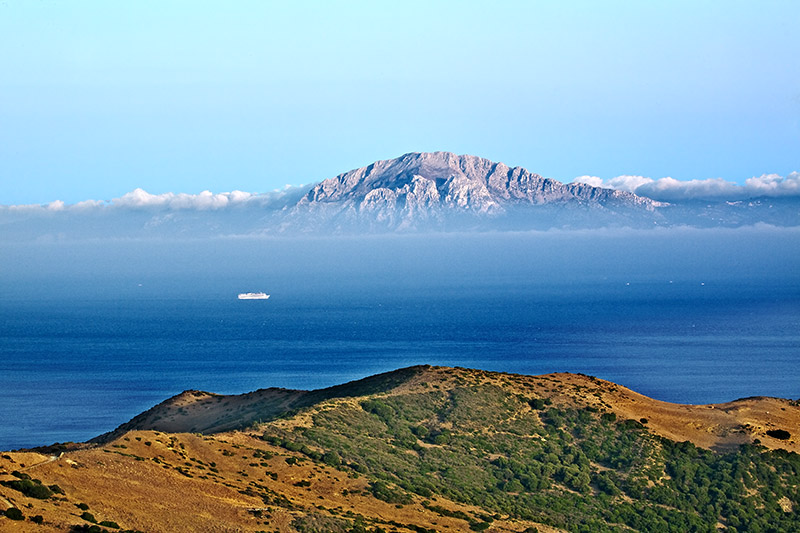Don Lashier said:
BTW I just noticed that you actually "cleared" parts of base image copies to isolate the zones. The problem with this is that it's very difficult to tweak the edges, or to make the transitions soft. You're better off to mask the various copies as you can always go back with the spray gun and tweak the mask with black or white, or blur it, to ease the transitions. Also, sometimes it's useful to fade a particular layer/zone, and without the full image on each image layer this may cause problems (transparency showing thru).
Sorry about replying to myself, but you can easily convert all your hard work to a masked version:
- To be safe, dup the image and work on the dup. I'll refer to this as the "working" image. Note that I'm using windows kb so for a mac sub command- for ctrl-.
- Create another temp work image the same size - you could do this on a temp layer instead but this may keep things a little easier to keep track of.
- fill the background on the temp image with black
- copy one of the partial image layers from the working image to the temp image. Use copy/paste rather than drag/drop so things align.
- set the transparency protect on the new layer this created on the temp image (checkboard button).
- select all (ctrl-a) and fill the layer with white. Only the non-transparent part should fill.
- dup the base image on the working file and move next to the origin layer.
- add a layer mask to this new layer on the working image (layer, add layer mask, reveal/hide doesn't matter as in the next step we'll replace the layer mask). A second thumbnail (mask) should appear on the layer in the palette.
- flatten the temp image, ctrl-a ctrl-c to copy, then alt-click the
mask (all white currently) of the new layer we just added in the working image layer palette. The image should turn white (showing the current mask). Ctrl-V to paste in the mask you created on the temp image.
- delete the origin (partial image) layer which has now been replaced by the masked full image
- relink the newly created layer to the clipping group (adjustments layers above) if required by pointing the mouse at the top border of the new layer and alt-clicking.
== if I haven't made a stupid mistake in my instructions (didn't step thru it as I wrote), the image should look as it did before, but you can now click on the mask and paint black or white with the spray gun, blur, etc., to tweak what shows. Any adjustments in the clipping group should behave as before. There's no doubt some shortcuts that could be taken as almost no one (certainly not myself) knows all the secrets of Photoshop. For instance, you could just build the new image layer stack on the temp image then drag/drop over the adjustment layers and re-create the clipping groups.
btw, does anyone know how to replace the actual image in an existing layer? I can't figure it out but there must be a way.
- repeat the above steps for each of the other image layers. You'll now have a much more tunable layer stack.
Things to note about masks:
- white allows that part of the image to show, black masks it off
- you can paint on or otherwise work on the mask (blur etc.) either while viewing the image or while viewing the mask itself, or both (using QuickMask mode which I won't go into here). The most useful is to paint (usually spraygun, if on edges set quite low 5% or so) or adjust on the mask while viewing the effect on the image. To do this click the mask thumbnail and paint or adjust away. If you alt-click the mask instead you'll be viewing the mask itself which is sometimes useful. Also if you want to copy from or paste to the mask you must be
viewing the mask layer (alt-click) before doing so.
- you can also add masks to adjustment layers which will restrict the effect to only the unmasked portion of the image. This is what I did for the haze remove using curves adjustment layers in my first version.
- if you have a hard edge mask constructed it can be very useful to gaussian blue to soften the transition. Use the preview to determine the best setting, but I usually find something fairly wide (10 to 20 pixels) works well.
- Contrast adjustment on the mask can also be useful in certain situations.
- you can often quickly create a mask by making a temp copy or layer of the base image, then posterizing using levels and/or curves, then either directly copy paste to a layer mask on a full normal image, or use the magic wand or color range selection to create a selection, then add a layer mask to a copy of the full image, optionally select either hide or reveal selection when the mask is created.
- the gradient tool is also handy for creating masks. I used this on the haze removal mask, and also used a gradient mask on an curves adjustment layer for the sky in my last version of your image to give some gradient to the sky.
ps: Just checked in PS and I did have ctrl- and alt- crossed up a couple times. Hopefully I got them all corrected now. One of the things that makes it so difficult to learn advanced features in PS is that so many shortcuts (unlike typical apps) have no menu equivalent which means you can't hunt the menus when you're unsure or first learning.
- DL
















